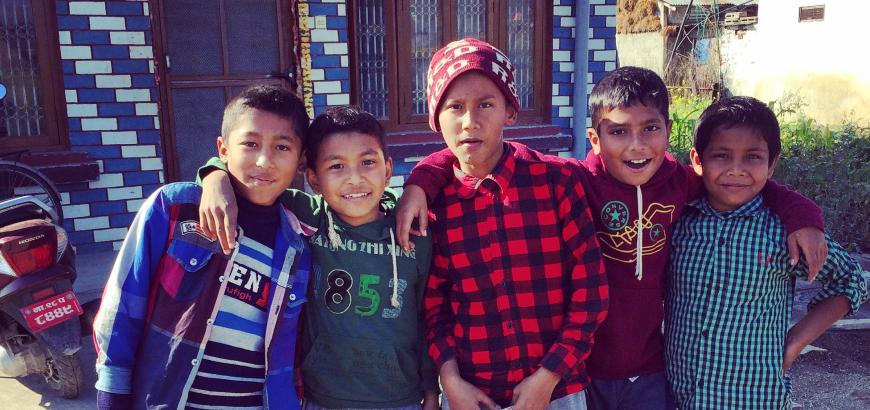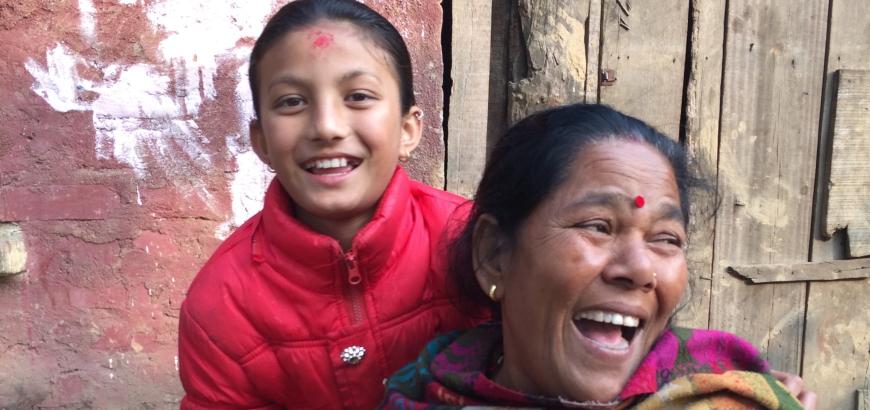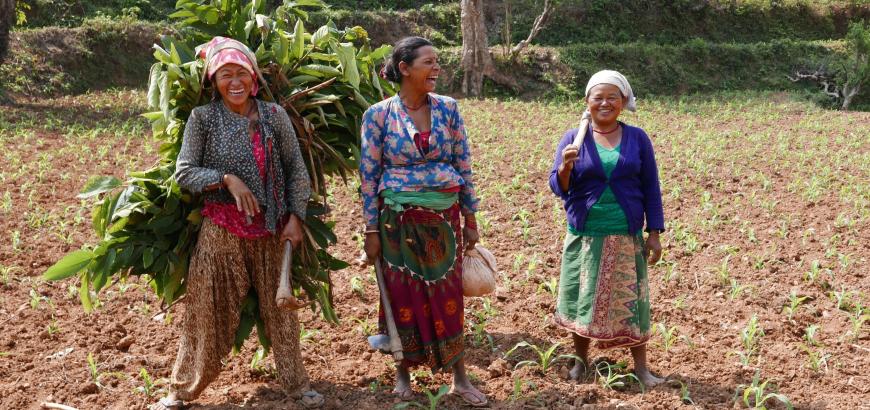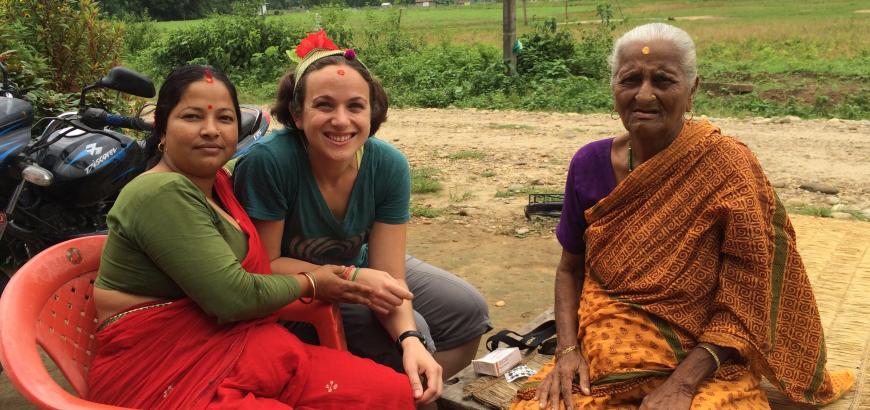Liminal in Nepal
When I first arrived in Nepal, the adjustments were sensory and it was exhausting. After I had been there for a while, I listened to the Home of the Brave podcast coverage of Nepal post-Earthquake where Scott Carrier and his daughter Jess Carrier described their experiences and talked about some of the same things about Nepal that had been most unfamiliar to me when I first arrived. Looking, I can chart my growth from that beginning against their observations: I remember noticing what they noticed. But once I had been in Nepal for a while, I hardly saw those things as noteworthy anymore, and I had mentally corrected a range of early mistakes (most notably mistaking packets of chewing tobacco/betel leaf that are everywhere in stalls for condoms, which are much harder to come by and would never be sold in such a public way). Despite some mispronunciations, I recommend listening the Carriers’ podcast, especially since it captures the sounds of Nepal so well. In fact, I remember that I was walking down a quiet road when I listened to it, and my brain was so attuned to those sounds that I kept checking around me for the motorbikes, the dogs, and the women talking that were all coming through their microphones, and not my immediate surroundings.
My shift away from constant awareness of what is uniquely Nepali has meant that I no longer needed to write as a way to process my experiences; my life in Nepal became my regular life, not some new and different thing. In short, it became normalized. And normal can be harder to write about, or at least if you’re trying to write thematically, which was the style I adopted in my blog
Below is a blog post I wrote shortly after listening to the Carriers’ podcast, and right after the inauguration of President Trump:
Another way of thinking about ‘normal’ is that I’m not quite on the outside anymore. So I forget, just a little, what is interesting about Nepal to outsiders. And while I am not really an outsider anymore, it’s a stretch to say I’m an insider. I am not. I am liminal.
I was talking about this with a friend, a sociologist, and she described my experience as liminal before I told her I was in the midst of writing this post. She explained it as, “where your identities aren’t measured and understood by the relationships around you.” I felt it perfectly summed out how I’m an inside-outsider. I have relationships and connections here in Nepal, but they are with people who understand very little about my ‘real’ life back home. They do not really know what’s important to me, how I define myself, what matters in my life. Arguably, I don’t really know that about their lives either.
This chasm of truly knowing what someone is about ‘on their turf’ was made incredibly obvious to me over this weekend of the inauguration, of the Womxn’s March, of the shooting on my campus at a protest. Deeply personal issues to me are essentially invisible or at least meaningless to others around me here. The few times I tried to communicate my experience were incredibly awkward. On November 9th my senior colleague here congratulated me on my presidential election as a genuine well-meaning way of saying ‘hey I know you had an election and that’s great you have a new president.’ He did this not really knowing my political identity, not knowing my fears or my grief. I started crying and stammered something about it being a bad thing for the most vulnerable people in the US. A few other times I’ve tried to share parts of myself it has fallen flat and so I don’t, I project that homewards in my communications with family and friends. Or towards the other Fulbrighters, who occupy similar liminality too.
Being liminal means I occupy this strange space where I am not an insider but I understand, a little, how the inside works and I can see it working. I believe this is the best way to do qualitative research, things are familiar enough to be able to know what to look for, but different enough where I see things happening and ask questions about that a full insider might not see as remarkable or interesting. When I notice things enough times to see trends, I ask someone about them. Just the other day I saw a naked toddler in his yard, about to be bathed at the family’s water pump. He had a loose thread around his hips, sort of like a low belt. I have seen this on other kids during interviews, usually if the child soils itself (diapers aren’t really a thing) and the parent strips the child of its fleece pants and gets a new pair from the line. I asked my research coordinator at the research center about this. She said that, until people die, they should never be truly naked. So everyone has some small cloth on their body at all times. She could not explain to me why they shouldn’t be naked, what nakedness means except that it is reserved for death. In this instance, I am enough of an insider that I know, see, and accept that children seem to wear strings. But enough of an outsider that I want to know more and I have to ask “why children? What does it mean?” Instead of assuming it’s about childhood, or maybe a marker of caste (much like the thread Brahmin men wear around their trunks), I get a more accurate answer, one that draws me towards the inside just a little more. I realize that it is not just children who wear this, but rather children are the only people I ever see naked (or almost-naked, as it were). Although, I do see more adults almost-naked here than at home because people in the country often bathe at their water pumps in mid-day (when it’s warmest). They are often visible from the road, men in underwear, shorts, or a sarong at the waist and women in sarongs tied at the chest, all lathering up in plain sight.
Despite all the things I’ve done that make me understand a bit more about life on the inside, from bathing at a pump to living with families to eating my daal bhaat [lentils and rice] with my hands; everything about me screams “foreigner” and “outsider” to Nepalis. I am an outsider and everyone knows it and they show it by staring or talking to me. More or less wherever I go. As I write I just came in from a 35-minute walk and every single person except one that I passed greeted me and asked me where I was going. A 12-year old boy on a bike said “Do you need a lift?” and a teenage girl leaned from the window of a school bus asking my name and wished me a good day. It’s a constant reminder that I am an outsider, I’m not like them, even if I feel like I know just a little bit more about their lives than most people they see who look like me. This makes me a funny sort of outsider, one that knows a lot more about Nepal than most foreigners who come through here.
In the village the stares and enthusiastic questions and yells from children are usually charming and make me smile. But there are times where it feels like I am being accosted, like they expect me to be something and I don’t know what it is. Since there are not that many people in this rural area and I am here for a while, I try to always be gracious and friendly. It’s likely I may run into some of these people again. And I went a full month without seeing another westerner, so they will remember me if we meet again. But it can be a performance on the days I just want to walk in silence, lost in thought or listening to my podcast. On my most recent pass by, I saw the oldest of three kids that are my most aggressive greeters see me coming and literally tremble and jump with excitement. It’s strange to be so important to someone’s day and it can feel like a lot of pressure. My foreign-ness is the single reason I am their local celebrity and sometimes I feel less like a human and more like a game.
I think this kind of attention has grown tiresome, at times, because I have been here for just shy of six months. I feel like I know more than sometimes people seem to expect of me. I don’t like being seen as a tourist when I am one, so I really don’t like it when I am not one. I usually try and indicate a deeper knowledge of Nepal by using Nepali. Nepalis are generally incredibly flattered and happy when people try and use any Nepali language at all. So many tourists never learn a word beyond “Namaste” (and sometimes they don’t even learn that). All this high and mighty ‘I’m not a tourist’ attitude falls apart when I actually am a tourist. When my friends visited that’s exactly what we were. It can be hard because I see things happen that I know Nepalis might find strange or offensive, such as passing or accepting food or money with the left hand. In seeing these small cases, I realize that my mental frame has shifted and I see the left hand differently now. I use it differently too, I use it less. I saw a photo of Trump at the inauguration, his left hand was on the bible (the same one that Lincoln was sworn into office with) and his right hand in the air, as is the typical arrangement. But I had a knee jerk reaction of how he was defiling this sacred and historical object with his left hand, how what he was doing was offensive until I realized that’s how all presidents have taken oaths. My six months in Nepal has been building and populating a new paradigm of thought and action. One that eases my time here, but also pulls me away from aspects of life at home. This new paradigm is one of new access to life in Nepal, but also liminality.
But I’m just moonlighting at liminality. I’m a temporary outsider in Nepal, a place where knowing just a little of the language wins me applause and respect. For immigrants to the US, liminality lasts for years. Decades. Lifetimes. Here, my language mistakes, such as accidentally asking if the meat is dog (kukur), instead of chicken (kukura) are met with forgiveness, humor. Americans are much less patient and forgiving with the process of learning to be American, of making mistakes at being an insider. Those who feel liminal in the US are treated as outsiders. Their liminality is their invisibility. My liminality in Nepal makes me more visible.
The boundaries around who can be an insider and an outsider are always being negotiated, but, at this fraught moment in America’s social history, it is a much more politically charged and visible debate. There are more displaced persons, refugees, asylum seekers, and immigrants than ever before in human history. And there is a huge counter-swing against these waves of outsiders needing an in. Many people do not want to let them in, even though they are likely not-too-distant descendants of groups that were, at one time, outsiders too. The process of acceptance and the criteria upon which people are accepted is complex, it varies based on what groups are coming, what skills and status characteristics they possess, where they try and move to, how they arrived. Sometimes they are let in, other times they are not. And this varies over time within a single group too. For example, Arabs were once seen as white, they were accepted as insiders or capable of becoming insiders. This has shifted from acceptance to fear in the post-9/11 era in large part because Arab-ness is actively linked with Islam in media. And the depictions of Islam are grotesquely skewed to create perceptions that mismatch the overwhelming majority of Muslims. The result is that Islam and therefore Muslims, especially Arab Muslims, are violently feared and deeply misunderstood. They are no longer accepted as insiders as easily as they were 50 years ago.
If things can change so easily, then can’t they be changed towards a more inclusive boundary? I would hope and think so, though, like the groups that comprise the playing field, the rules of inclusion are always changing. As someone who deeply values experiential and interactional learning, I firmly believe that this debate over boundaries would have fewer teeth and less violence if more people, more insiders in the US, had the opportunity to go somewhere and be an outsider, an ‘other’ for long enough to understand what it’s like. Long enough to break the comforts of little islands of ‘insider-ness’ in an outside land (meaning, it does not count to take a vacation at an all-inclusive resort in Mexico where the only Mexicans you interact with are paid to be nice to you and make you feel good). No, you must be an outsider long enough to be the true minority in a situation, long enough to be totally lost and truly need someone’s help and guidance. Long enough to feel grateful when people are forgiving, and human, and welcoming towards you. Long enough to know that, even if they stare, the next thing they will do is smile if you smile first. And then greet you, and ask you about your family, and sometimes offer tea. And not because they want to sell you something, but because they want to know about you. Because they see you. They see that you are outside and that want you to feel a little more welcomed inside.
Ande Reisman is a PhD student in Sociology. She spent the 2016-17 academic year as a Fulbright scholar in Nepal.



